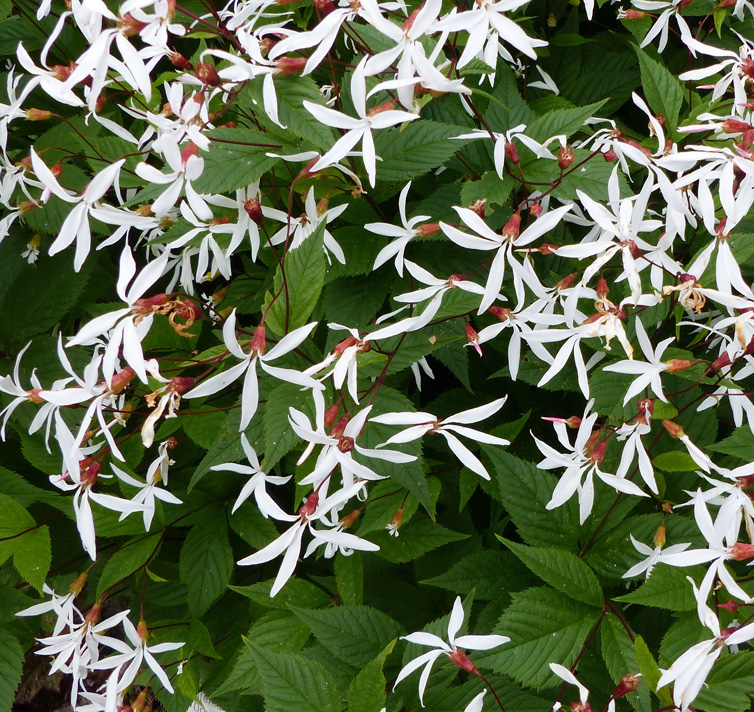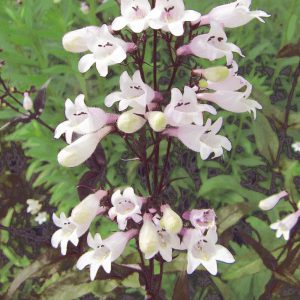- 1-9 pkts $4.50
- 10 pkts FREE
- Express post $12
Gillenia trifoliata
BOWMAN’S ROOT
Beautiful Gillenia trifoliata is little known in Australia, but adored by those who have finally found it.
It is not a hard plant to grow in the garden – so don’t let “rare” put you off.
Covered with flocks of white butterfly flowers
A Gillenia trifoliata in flower is a thing of breathtaking beauty.
Looking as if it has been covered by a flock of white butterflies.
Highlighted by rose-red
The clusters of dainty 5 winged flowers are highlighted by rose-red calyx (which remain decorative even after the petals have finally fallen).
Plus blooms are also borne on fine, rose flushed stems.
So the overall effect is so lovely against the fine, fresh green foliage.
Dainty in flower & foliage
Gillenia trifoliata is the definition of dainty, in both flowers and foliage.
The fine winged flowers are backed by dainty foliage, rather like the lacy leaves of a Japanese Maple.
Spring summer blooms followed by vivid autumn foliage colour
Then in autumn the Maple-like foliage flames with vivid autumn golds and reds.
So lovely Gillenia trifoliata pulls its weight in the garden all through spring, summer and autumn, with flowers, beautiful foliage, and then autumn colour.
Before taking a well-earned rest over winter with its sturdy rhizome, then re-shooting with lacy foliage and flowers next spring.
Hardy perennial clump of lovely flowers & foliage
Gillenia trifoliata is a clump forming perennial.
Which shoots up to a 60-90cm. tall fountain of flowers and foliage each spring.
It is not invasive in any way, and instead just thickens to an even more beautiful clump each year from the tough underground rhizome.
Very low maintenance & easy to grow
The only work to do annually is to cut the foliage back close to the ground after autumn – just to tidy up.
Hardy, easy Gillenia is virtually untroubled by pests and diseases, and is a great survivor because of the underground rhizome.
Shade beauty
Gillenia trifoliata is a highlight of any shaded garden.
It enjoys the dappled light and shade under taller trees and shrubs; or morning sun; or well-lit full shade such as in the shadow of a building.
Winter frost & summer humidity hardy
And can tolerate winter cold and frost down to below -20°C , then front up to summer humidity and temperatures above 30°C.
It is a native of woodlands down the eastern side of North America – from Canada to Alabama – so from cold to hot, humid.
Not fussy about soil – from sandy to clay
Gillenia trifoliata is not fussy about soil type – thriving in soils from light sandy to heavy clay based.
Providing it has some humus or mulch, and acid to neutral pH, and does not remain waterlogged for long periods – it will purr.
Not a thirsty plant
Nor is it a thirsty plant. Average garden watering during hot weather is all that it needs.
Particularly if it mulched in summer to maintain even soil moisture, as all woodland plants enjoy.
Why Bowman’s Root???
Native American First Nation peoples used the dried roots of the plant as medicine, for its laxative effects.
SEED SOWING ADVICE: Warm: Cold: Cool sequence
Seeds are best sown in autumn, to use the cold of winter to break the natural seed dormancy.
Sow seed indoors in a punnet for quicker response: First sow the seeds in a punnet on the surface of good quality seed raising mix.
Then cover the seeds to a depth of 6mm. with fine sieved seed mix or fine vermiculite.
Now moisten by standing the punnet in a shallow water bath, and allowing the moisture to percolate up to the surface from below. This will ensure the mix is thoroughly moist but not drenched.
Label the punnet with the name and date sown.
Now place the moist, sown punnet in a warm, well-lit position (but no direct sunlight).
Temperatures of approx. 18-22°C are best for this pre-conditioning stage.
You can use a temperature controlled heat mat if you have one to maintain warmth.
Continue to keep the punnet consistently moist by misting from a spray water bottle regularly.
Covering the punnet with a clear plastic cover, plastic bag, or glass helps to maintain consistent moisture and prevent drying out.
The moist, sown punnet should be in the warm place for 4 weeks.
Now give a pretend winter
For best germination seeds now need a period of chilling (a pretend winter) – so wrap the sown, moist punnet in cling-wrap or a plastic bag and place in fridge (not freezer) for 6 weeks.
Then take out, unwrap punnet, and keep moist in COOL well-lit position again.
Seeds need good light to sprout, but the punnet should not be in any direct sunlight.
Temperatures of 10-15°C are best for optimum germination at this stage – so timing your sowing so the punnet can be put outside in the winter cold is important.
Make sure you cover the punnet with wire or shade cloth so the seeds are protected from birds and mice.
Seeds germinate in approx. 30 days.
Then it is worth returning the moist punnet to the fridge for another 6 weeks, as more seeds will often germinate after they feel they have had 2 winters.
Direct sow in the garden: Or sow seeds directly in garden in autumn and leave to get the required chilling from winter and nature, before germinating in the early spring.
Seed Count: 3 seeds per packet approx. (Seed of this rarely seen beauty is scarce)
Click here for Nursery Open Days & Open Gardens Information
https://www.gardivalia.com.au/open-gardens
Click here to go back to Seeds Shop
https://www.seedscape.net.au/shop/
Related products
-
Add to WishlistAlready In WishlistAdd to Wishlist
-
Add to WishlistAlready In WishlistAdd to Wishlist
-
Add to WishlistAlready In WishlistAdd to Wishlist
-
Add to WishlistAlready In WishlistAdd to Wishlist





